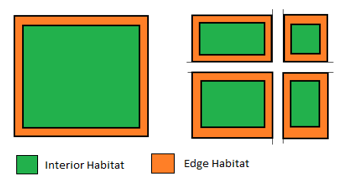Landscape ecology is the study of landscape structure, how habitat is connected and how wildlife move throughout a landscape in search of food, shelter, and mates. A landscape is comprised of patches, or relatively homogenous areas of land that differ from their surroundings. The most extensive, most connected, or most influential landscape element of an area is called the matrix. In Alberta’s Parkland Natural Region, most of the matrix is agricultural.
A natural habitat might face various disturbances. Human activities such as agriculture, natural resource exploitation and infrastructure development can result in habitat removal. Habitat degradation, or the decline in habitat quality, may result from encroachment of invasive species. Furthermore, habitat fragmentation is the process by which habitats are segmented into fragments by development, or by water diversions in the case of aquatic habitat. One consequence of habitat fragmentation is the creation of edges, which are transitional zones between two different types of ecosystems. Edge effects are the result of interactions that occur at these edges, and may penetrate variable distances into a landscape fragment. The study Edge effects in fragmented forests: implications for conservation outlines three types of edge effects on fragments:
Abiotic effects – Edges may alter environmental conditions of a fragment such as light exposure, temperature and soil moisture. For example, a cropland would allow more sunlight to reach the ground than an adjacent forested ecosystem, likely resulting in an increase in light exposure and temperature on the forested side of the edge.
Direct biological effects – The physical conditions of a fragment changed by edge effects may affect the distribution and abundance of plants and animals as they respond to these new conditions.
Indirect biological edge effects – Edge effects can change the way species behave and interact with each other. For example, greater light exposure at an edge may result in more productive leaf growth, which can lead to more herbivorous insects, in turn attracting more birds, and so on. There may be changes to patterns in predation, parasitism, competition, herbivory, pollination and seed dispersal.
Habitat loss, degradation and fragmentation can adversely affect many wildlife species. Food resources and shelter become scarcer as habitat is lost and species in a landscape fragment must compete with encroaching edge species. Terrestrial wildlife is forced to migrate across human infrastructure, especially roads, and are at risk of being hit by vehicles. Aquatic species might get stuck and die if an obstacle is built in their path. Migratory species may have difficulty finding places to rest and feed along their migration routes.
Despite the challenges, a fragmented landscape is still crucial for wildlife. Though habitat may have been reduced, stepping stones, corridors and larger patches can provide important refuge for wildlife. Stepping stones are patches of suitable habitat, between larger patches of suitable habitat, which migratory wildlife can use to rest, shelter and feed. Corridors are physical linkages between habitat patches where organisms can feed, breed and travel from one patch to another.
EALT operates in a highly fragmented landscape, but our conservation lands provide important habitat and linkages.
EALT operates close to urban areas in a region that has largely been converted to other land uses. Our conservation lands are generally small, but serve an important ecological function. Conserving these types of landscapes requires a multi-step approach:
Maintain – Maintain the existing condition of habitats by mitigating disturbances and implementing conservation measures such as establishing a land trust. It is generally easier and more cost efficient to prevent the effects of degradation than it is to reverse them.
Improve – When habitat has been degraded, actions can be taken to improve conditions and remove threats. Modified habitats require active management to restore ecosystem processes, improve soil structure, encourage regeneration of plant species or reintroduce flora or fauna species.
Restore – When habitat is completely gone, it can sometimes be restored by methods such as converting lands back to native vegetation or reconstructing lost wetlands. In some cases, the restored habitat may not be as productive as the original habitats, but can still serve important ecosystem functions.
You can help us conserve important wildlife corridors and habitat by donating or volunteering. Take a look at our nature factsheets for more information about why nature conservation is important.
By: Rannee Liu, EALT volunteer and SCiP intern




